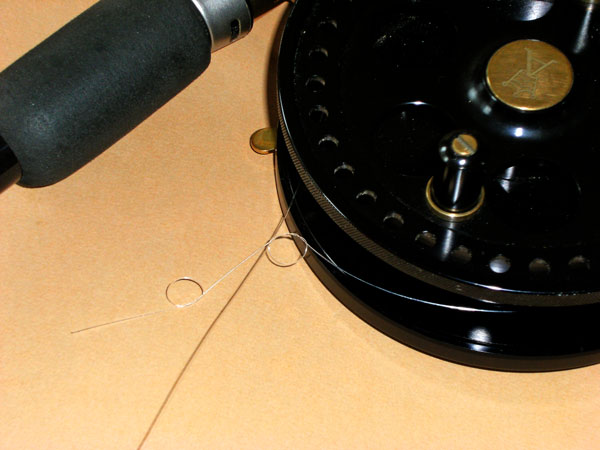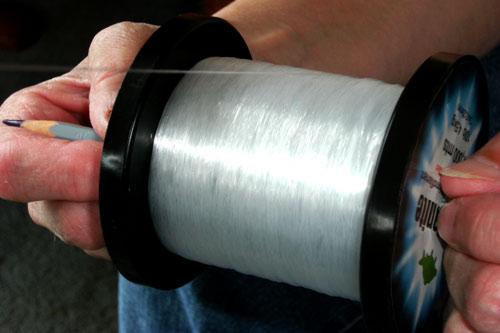FIRST OF ALL, LET’S DISCUSS THE TYPES OF LINE THERE ARE FOR FISHING THESE DAYS.
The ever popular monofilament has come on in leaps and bounds over the years and is now available in thinner and more supple varieties than ever it was. However, with thinness there comes a price in that the amount of stretch in the line isn’t as noticeable as in thicker lines because often, the thinner lines are pre-stretched. This can be a good thing for anglers since striking into a fish needs less effort, particularly at range.
You may also hear of co-polymer lines and these have the look and appearance of monofilaments, but some can be a fusion of several thinner filaments to make up a thicker and stronger line. With these types of line, if a part of it suffers any damage it weakens not only in that one area, but across the length of line exposed. In other words, if you are fishing with 20 yards of line off the reel and it is damaged 3 yards from the hook, the line can be just as weak at the rod tip.
The latest developments in fishing line technology are taking us to fluorocarbons, supposedly invisible to fish when submerged. This is because the refractive index of the line is close to water and therefore difficult to see. The down side is that some of these lines can be harder and stiffer so some manufacturers have combined co-polymers with fluorocarbon coatings to offer the best of both worlds.
The last type of line (other than fly lines) we have is braid. Again these are thinner lines of no more than thousandths of an inch across, but woven into a braided form. They lack stretch, sometimes as little as 1% or less, and are popular with sea and lure anglers, although they are now catching on with many coarse anglers for feeder fishing at range. Beware when using such line that you choose a soft action rod so as not to damage the fish’s mouth in any way.
I’m not going to go into relevant diameters of the lines for their given breaking strains because that is a subject for much controversy. Suffice to say that braids overall are much thinner than their monofilament counterparts for their breaking strain, but suffer badly from abrasion against sharp objects such as stone or ironwork and can therefore break much more easily.
CALCULATING HOW MUCH LINE
With a centrepin reel we are normally fishing close in because unless you are an expert in the Wallis casting method, getting the bait well out with a centrepin is hard. However. they are popular for margin fishing for carp and also in the river for both trotting a float or barbel fishing, both of which might just take a little less line than the angler would expect. About 50 yards is normally sufficient for all these types of angling.
Most lines are supplied on 100 or 150 yards spools, but bulk spools are also available ranging from 300 yards to 2000 yards. You could just wind on as much line as you think necessary, take a guess and trust to luck, but here is a better way of making the calculation of what you need to put on your centrepin reel.
First of all, find out the reel’s spool diameter. That’s not the very outer edge of the reel, but the inner bit, the bed of the spool on which the line will lay. On my centrepin the outer diameter is over 4½ inches, but the bit where the line lays is only 4 inches, so that’s the figure we use. You can just hold a ruler up against the side and closing one eye take the measurement off the ruler.
Now you need to know what the circumference is and to calculate that you multiply the diameter by the factor known as Pi. Pi has a value of 3.14 always (Pi has actually got a much longer mantissa, but for our purposes 3.14 will suffice.) So my reel’s 4” x 3.14 gives us 12.56 inches per turn of the spool and since a centrepin only has a retrieve ratio of one to one that’s all you’re going to get by turning the handle one full cycle.
Now you need to calculate the inches in 50 yards, that’s 50 times 36 inches. That gives us 1800 inches and you now divide that by the circumference of the spool, 12.56 inches, giving us 143 turns of the handle. Let’s say 145 to 150 turns to give us a tiny bit to play with.
And that’s it, you would have 50 yards, or just over, of line on your centrepin, more precise than guesswork, eh? By calculating this beforehand you will get two loadings of the reel out of one 100 yards spool of line or 3 loadings from a 150 yards spool. The manufacturers tend to be generous so there’s usually a few yards more on a spool than stated on it’s label (sometime because you get 100 metres, which is nearly ten yards more).
LOADING THE LINE ON THE SPOOL.
Because a centrepin is a direct drive, i.e.: the line comes straight off in the direction of the rod’s eyes, loading the line on is easy.
Put the reel on the butt section of a rod with at least one rod ring on it and feed the line through the ring then onto the reel. Fasten the line to the reel by means of a slip knot or an arbor knot. You might want to physically wind a couple of turns onto the reel just to stop the loop of line slipping on the reel, but if you go over the top of the reel before tying the arbour knot, it will tighten around the spool and stop it slipping.

The arbor knot all ready to tighten
Have someone hold the main spool of line on a pencil or piece of dowelling with their thumbs at either end keeping a little tension on it just to stop it letting line off accidentally. The line should come off directly in the direction of the rod’s eye. You should pinch the line lightly between your thumb and forefinger to add a slight amount of pressure to the line whilst winding on and also to feel for any imperfections, kinks or abrasions in the line.

Hold spool of line on a pencil – line comes straight off.
Now, wind on the line counting the number of complete turns of the reel’s handle until you get to 145 or whatever suits you. As you wind on, move your thumb and forefinger, the ones pinching the line, from side to side to distribute the line evenly across the surface of the reel’s spool. That’s all there is to it, 50 yards or thereabouts of line and you’re ready for action.
If you have noticed any abrasions or kinks in the line whilst loading it then it might be best to scrap it and start again, you never know when you might have to rely on that line to land the fish of a lifetime. Don’t forget to mark the spool of new line in some way so you’ll remember that it no longer has the full 100 or 150 yards of line on it. Store it in a dark and fairly dry area and it should keep for years.










